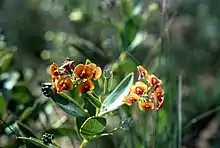Daviesia ovata
Daviesia ovata, commonly known as broad-leaf daviesia,[2] is a species of flowering plant in the family Fabaceae and is endemic to a restricted part of the south-west of Western Australia. It is a dense, bushy, glabrous shrub with egg-shaped to elliptic phyllodes and orange and maroon flowers.
| Broad-leaf daviesia | |
|---|---|
 | |
| Daviesia ovata on Mount Manypeaks | |
| Scientific classification | |
| Kingdom: | Plantae |
| Clade: | Tracheophytes |
| Clade: | Angiosperms |
| Clade: | Eudicots |
| Clade: | Rosids |
| Order: | Fabales |
| Family: | Fabaceae |
| Subfamily: | Faboideae |
| Genus: | Daviesia |
| Species: | D. ovata |
| Binomial name | |
| Daviesia ovata | |
Description
Daviesia ovata is a dense, bushy shrub that typically grows to a height of up to 1.8 m (5 ft 11 in) with erect, prominently ridges branchlets. Its phyllodes are scattered, erect and egg-shaped to elliptic, 28–77 mm (1.1–3.0 in) long and 14–37 mm (0.55–1.46 in) wide. The flowers are arranged in leaf axils in groups of eight to eleven flowers on a peduncle 14–30 mm (0.55–1.18 in) long, the rachis 5.5–7.0 mm (0.22–0.28 in) long, each flower on a pedicel 3.5–7.0 mm (0.14–0.28 in) long with bracts 2–3 mm (0.079–0.118 in) long at the base. The sepals are 4.5–5.5 mm (0.18–0.22 in) long and joined at the base, the upper two with lobes about 1.5 mm (0.059 in) long and the lower three lobes about 1 mm (0.039 in) long. The standard petal is elliptic with a notched tip, 7–8 mm (0.28–0.31 in) long, 8.5–9.5 mm (0.33–0.37 in) wide, and orange with a red ring around a yellow centre. The wings are 6.5–10.5 mm (0.26–0.41 in) long and the keel about 6 mm (0.24 in) long and maroon. Flowering occurs in September and the fruit is a triangular pod about 14 mm (0.55 in) long.[3][2]
Taxonomy
Daviesia ovata was first described in 1864 by George Bentham in Flora Australiensis from specimens collected by James Drummond.[4][5] The specific epithet (ovata) means "wider below the middle".[6]
Distribution and habitat
Broad-leaf daviesia grows among granite rocks in low mallee-heath or shrubland near Mount Manypeaks, east of Albany in the Esperance Plains biogeographic region of south-western Western Australia.[2][3]
Conservation status
This daviesia is listed as "Threatened" by the Western Australian Government Department of Parks and Wildlife,[2] meaning that it is in danger of extinction.[7]
References
- "Daviesia ovata". Australian Plant Census. Retrieved 8 March 2022.
- "Daviesia ovata". FloraBase. Western Australian Government Department of Biodiversity, Conservation and Attractions.
- Crisp, Michael D.; Cayzer, Lindy; Chandler, Gregory T.; Cook, Lyn G. (2017). "A monograph of Daviesia (Mirbelieae, Faboideae, Fabaceae)". Phytotaxa. 300 (1): 71–73. doi:10.11646/phytotaxa.300.1.1.
- "Daviesia ovata". APNI. Retrieved 8 March 2022.
- Bentham, George; von Mueller, Ferdinand (1864). Flora Australiensis. Vol. 2. London: Lovell Reeve & Co. p. 72. Retrieved 8 March 2022.
- Sharr, Francis Aubi; George, Alex (2019). Western Australian Plant Names and Their Meanings (3rd ed.). Kardinya, WA: Four Gables Press. p. 269. ISBN 9780958034180.
- "Conservation codes for Western Australian Flora and Fauna" (PDF). Government of Western Australia Department of Parks and Wildlife. Retrieved 8 March 2022.
